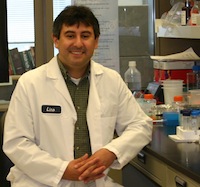Lino Gonzalez, Ph.D.
This article was originally published in 2005.
 It wasn't until the "dot com" boom and the explosion of startup biotechnology companies in the late 1990s that it occurred to me that a career in industry could be a possibility. During these years, I was building my scientific reputation and publication record as a postdoc at Stanford University. For many new Ph.D. graduates, accepting a postdoctoral position or job in industry is perceived to be equivalent to closing the door on an academic career. The catch is, if you have never experienced working in industry, how do you know you will like it?
It wasn't until the "dot com" boom and the explosion of startup biotechnology companies in the late 1990s that it occurred to me that a career in industry could be a possibility. During these years, I was building my scientific reputation and publication record as a postdoc at Stanford University. For many new Ph.D. graduates, accepting a postdoctoral position or job in industry is perceived to be equivalent to closing the door on an academic career. The catch is, if you have never experienced working in industry, how do you know you will like it?
So, naturally, I was worried that industry might be a death-knell into scientific obscurity. On the other hand, I recognized that biotech companies had exceptional resources and access to ground-breaking technologies. I was attracted by the practical aspect of developing therapeutics to treat patients and the prospect of spending more time in the lab, rather than writing grants and preparing lecture material.
Entering the Corporate World
After my academic postdoc, I interviewed exclusively at biotechnology companies. Some reinforced my original concern. I remember being asked during an interview how I felt about leaving academia. I was cautioned that research in industry was very different and not focused on publications. Immediately, I heard that scientific death-knell. I was just about to accept this fate when I received a phone call inviting me to interview at a company in South San Francisco. When I visited, I was struck by the fact that so many of the scientists in the department had spent the majority of their professional careers there. They were respected in the scientific community and recognized for their contributions. At first, I thought there must be some reason why these scientists felt compelled to remain with the same company for over 20 years. Another scientist handed me a pile of publications from his lab. Whoa, publications? Like in academia, scientific creativity was highly valued, and scientists were encouraged to publish and participate in scientific meetings. The line between corporate and academic research was blurred.
A Short Course in Biotech History
To understand how this corporate culture came about, let me review a little biotech history. Twenty-nine years ago, a venture capitalist named Robert Swanson recognized the commercial implications of technology that was being developed in the laboratory of Dr. Herbert Boyer at the University of California, San Francisco. The technology was called recombinant DNA, and it made possible the production of human proteins, such as insulin, in bacteria. Swanson called Boyer and managed to secure a 10-minute meeting, during which they agreed to form a company. They hired a few key scientists and set out to prove they could make a human protein in bacteria. Stephen S. Hall has chronicled these events in a book [Hall & Watson 2002]. Today, the original converted warehouse where those first experiments were done is still standing, surrounded by a growing campus of over 30 buildings. The company was named Genentech, short for Genetic Engineering Technology.
Postdocs [at Genentech]...enjoy an academic-like freedom to develop innovative research
Boyer had strong feelings about the philosophy behind the original business plan. He was an academic, so he knew how important it was to bring in scientists who were outstanding and provide them with opportunities to establish their own reputations. He insisted that scientists publish their research and interact with the scientific community. He felt that this was extremely important for attracting outstanding young scientists into an industrial setting. "We tried to set up an atmosphere which would take the best from industry and the best from the academic community and put them together," Boyer recalled during an interview for the Bancroft Library. Therefore, it is not surprising that recently many well-established academic scientists, including Drs. Marc Tessier-Lavigne, Andrew C. Chan, and Richard Scheller, have not hesitated to move to Genentech.
The Best of Academia to Industry
Clearly, there is a benefit to bringing the best of academia to industry. Postdoctoral students bring an infusion of fresh ideas and new techniques. Moreover, postdocs gain valuable insight from working in industry. I am sure that most postdocs who have experienced industry have had their eyes opened to new possibilities. Because of this win-win situation, Genentech continuously supports over 60 postdoc positions in research. The postdoc tenure typically lasts three to four years and includes semi-monthly internal meetings and an annual offsite meeting where their research is shared within the group. Postdocs are expected and encouraged to do cutting edge science that will lead to new discoveries and publications. Importantly, they are not required to work on projects that have direct therapeutic applications and therefore enjoy an academic-like freedom to develop innovative research.
The Value of an Industry Postdoc
I think one of the most valuable experiences for an industry postdoc is the exposure to the corporate culture and research environment. The extent of collaboration and the willingness to work together was one of the biggest differences I noticed in coming to industry. Another significant difference is the multifaceted nature of a company. Although it would be easy to overlook these aspects, I encourage postdoctoral fellows in industry to learn from people outside of research. Try to learn management philosophies from different corporate leaders. Learn what works and what does not. These are experiences that are difficult to obtain from an academic setting but could be extremely valuable down the road in managing a lab, a department, or an institute as your career progresses.
I strongly encourage considering companies with strong diversity initiatives. Genentech supports a number of affinity groups that focus on diversity issues. The VIDA Latino Professionals group, for example, focuses on educational and health outreach to the local community and on the professional development of its members. We are also involved in recruiting initiatives to help identify qualified candidates to increase corporate diversity. Affinity groups are also a wonderful way to meet people around the company. The groups provide a sense of community and allow us to learn from each other's experiences and expertise.
After the Corporate Postdoc
Where do the Genentech postdocs go after finishing their fellowships? Most continue their careers at other companies. A few find permanent research positions internally. There are some examples of fellows transitioning into areas such as project management or business development. But perhaps most surprising is the fact that many postdocs return to academia (see the Postdoctoral Program webpage at www.gene.com and this article [Martin 2004]). In this article, I have focused on Genentech, but there are many other opportunities to do postdoctoral work in industry. I hope that these words and the vision of Genentech's founders will serve as a roadmap in what to look for in a company. If you choose to do your postdoctoral training in industry, be selective and realize that you can leave your options open to a whole world of possibilities.
Hall S and Watson J (2002) Invisible Frontiers: The Race to Synthesize a Human Gene, Oxford University Press
Martin B (2004) From industry to academia. Nature 429:324–325.
Lino Gonzalez at his Genentech lab. (Credit: L. Gonzalez)
L. Gonzalez (2023) The Corporate Postdoc -- A World of Possibilities. DiverseScholar 14:3
Dr. Lino Gonzalez is a scientist at Genentech, Inc. Any opinions expressed in this article are solely those of the author.
Leon Zhao assisted in formatting this current version of the online article. This text first appeared in the Summer 2005 issue of the SACNAS News. This article is used with the permission of SACNAS. The text later appeared online as a web article in 2013 on the original MinorityPostdoc.org website. DiverseScholar is now publishing original written works. Submit article ideas by contacting us at info@DiverseScholar.org.
Republished online 31-Dec-2023
Originally published online 9-Apr-2013
